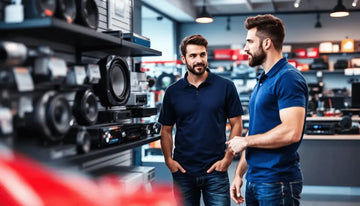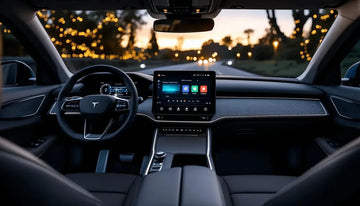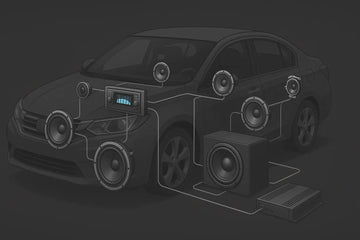Whether you’re stuck in traffic during your daily commute or cruising down the highway with friends, your car audio system transforms every ride into an immersive experience. The evolution from basic AM radio to today’s sophisticated systems with Apple CarPlay, satellite radio, and wireless connectivity has revolutionized how we enjoy music while driving.
Modern car audio encompasses much more than just playing music. Today’s systems integrate GPS navigation, hands-free calling, and smartphone connectivity to create a comprehensive multimedia hub for your vehicle. Understanding the components, options, and upgrade potential of car audio systems can help you make informed decisions about improving your driving experience.
In this comprehensive guide, we’ll explore everything you need to know about car audio systems, from basic components to professional installation options, helping you choose the perfect setup for your vehicle and budget.
What is Car Audio
Car audio refers to the integrated system of electronic components designed specifically for vehicles to reproduce, amplify, and manage sound. Unlike home audio systems that operate in controlled environments, car audio systems must overcome unique challenges including road noise, engine vibration, irregular cabin shapes, and varying electrical conditions.
The primary components of any car audio system include speakers, amplifiers, head units, and subwoofers. These work together to deliver clear, powerful sound that can compete with ambient noise while you’re driving. Modern systems also serve multiple purposes beyond entertainment, functioning as communication hubs for hands-free calling and navigation centers with GPS functionality.
Car audio systems differ significantly from home stereo setups due to space constraints, power limitations, and acoustic challenges. Vehicle interiors present hard reflective surfaces and irregular shapes that require careful tuning and component placement to achieve optimal sound quality. The electrical system must also handle varying voltage conditions and potential interference from other vehicle electronics.
The main purposes of contemporary car audio extend far beyond simple music playback. Today’s systems provide entertainment through multiple sources including radio, streaming services, and stored digital files. They enable safe communication through Bluetooth connectivity and hands-free calling features. Additionally, they serve as navigation centers, displaying turn-by-turn directions and traffic information to enhance your driving experience.
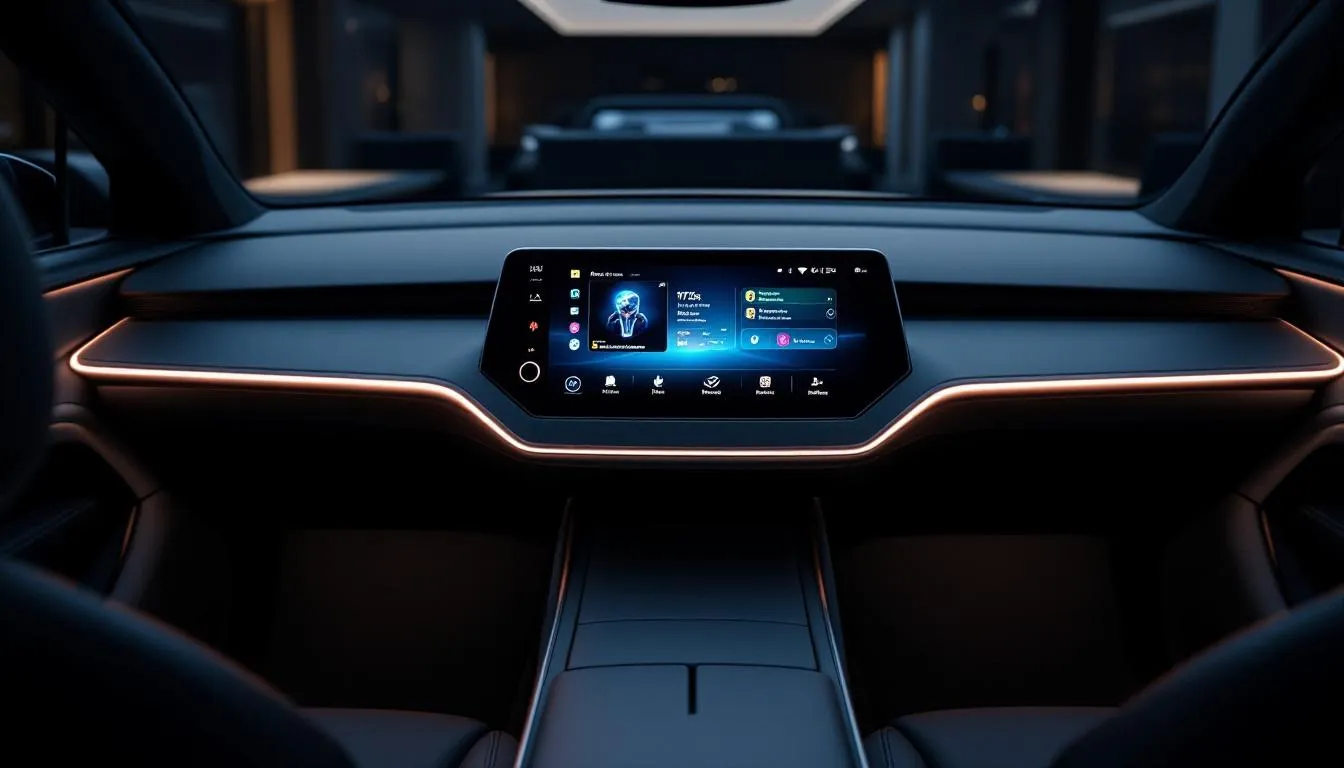
Essential Car Audio Components
Understanding the core components of car audio systems helps you make informed decisions when planning upgrades or troubleshooting issues. Each component plays a crucial role in delivering high-quality sound and modern functionality.
The head unit serves as the control center of your entire car audio system. Also called a stereo receiver, this dashboard-mounted device manages volume control, input source selection, and basic sound adjustments like bass and treble. Modern head units integrate with infotainment systems, supporting features like Apple CarPlay, Android Auto, satellite radio, and Bluetooth streaming. Many units now feature touchscreens and digital displays, replacing traditional button-heavy designs. The head unit typically houses a preamplifier that prepares low-level signals for further amplification.
Speakers transform electrical signals into sound waves that you actually hear. Car audio systems utilize several speaker types to cover different frequency ranges effectively. Coaxial speakers combine woofers for low and mid-frequency sounds with tweeters for high frequencies in a single unit, making them popular for factory installations due to their simplicity and cost-effectiveness. Component speakers separate these drivers, allowing for superior sound quality and flexible placement options that audiophiles prefer for custom installations.
Amplifiers boost audio signals to drive speakers effectively, preventing distortion and enabling higher volume levels. While most head units include small built-in amplifiers sufficient for basic needs, dedicated amplifiers provide significantly more power and cleaner sound reproduction. Quality amplifiers typically deliver 50-150+ watts RMS per channel, supporting demanding speakers and subwoofers while maintaining audio fidelity at higher volumes.
Subwoofers specialize in reproducing deep, low-frequency bass sounds that regular speakers cannot effectively handle. These dedicated bass speakers prevent unwanted vibration in other components while maximizing dynamic range. Proper subwoofer installation often requires custom enclosures designed to optimize bass response for your specific vehicle’s acoustics. Installing car audio components, such as speakers and amplifiers, can be done professionally to ensure optimal performance and a factory-like appearance.
Additional accessories include crossovers that direct appropriate frequency bands to correct speaker components, and specialized wiring designed to handle the power requirements and electromagnetic interference common in vehicle environments. Proper install and installing of these components is crucial for achieving the best sound quality and system reliability. Professional-grade installations may also incorporate sound-deadening materials to reduce road noise and improve overall audio quality.
Factory vs Aftermarket Car Audio Systems
When considering car audio options, understanding the fundamental differences between factory and aftermarket systems helps you evaluate upgrade potential and budget requirements.
Factory systems come pre-installed by vehicle manufacturers and typically focus on basic functionality rather than audiophile-quality sound. These systems integrate seamlessly with vehicle controls and maintain warranty coverage, but often feature limited power output, basic speakers, and minimal customization options. Most factory systems include essential features like radio, CD playback, and basic Bluetooth connectivity, but may lack advanced features like Apple CarPlay or high-quality amplification.
Aftermarket systems offer superior sound quality and extensive customization options that can transform your listening experience. These systems typically feature more powerful amplifiers, higher-quality speakers, and advanced connectivity options including wireless streaming and smartphone integration. Professional aftermarket installations can be tailored to your specific music preferences and vehicle acoustics.
|
Feature |
Factory Systems |
Aftermarket Systems |
|---|---|---|
|
Sound Quality |
Basic/Adequate |
Superior/Customizable |
|
Power Output |
15-25 watts RMS |
50-150+ watts RMS |
|
Speaker Quality |
Standard grade |
Premium materials |
|
Connectivity |
Limited |
Extensive options |
|
Installation |
Pre-integrated |
Professional required |
|
Cost |
Included with vehicle |
$200-$5000+ |
|
Warranty |
Manufacturer covered |
Varies by retailer |
|
Customization |
Minimal |
Extensive |
Cost considerations vary significantly between approaches. Factory upgrades during vehicle purchase typically offer better value than dealer-installed aftermarket systems. However, purchasing aftermarket components independently and having them professionally installed often provides the best performance per dollar spent.
Upgrade potential depends largely on your current system and vehicle. Some vehicles with premium factory systems may require complex integration to maintain features like steering wheel controls and vehicle information displays. Others with basic systems offer straightforward upgrade paths that dramatically improve performance without complicated installation procedures.
Warranty implications require careful consideration when replacing factory systems. While aftermarket installations typically don’t void your vehicle warranty, improper installation could affect coverage for related electrical issues. Working with a reputable shop ensures proper integration and warranty coverage for aftermarket car audio systems. Professional installation from approved shops often includes separate warranty coverage for both parts and labor.
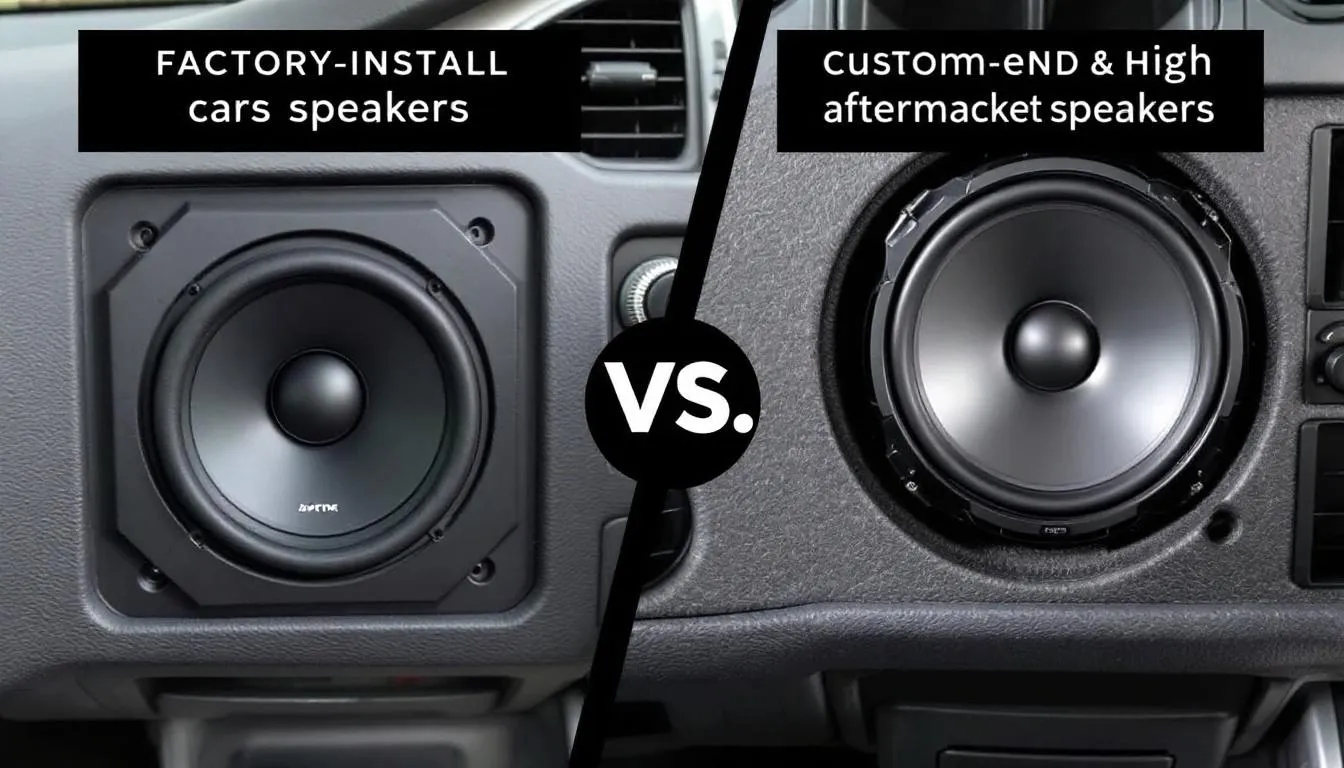
Benefits of Upgrading Your Car Audio
Investing in car audio upgrades delivers immediate improvements in your daily driving experience while providing long-term value for your vehicle. The benefits extend beyond simple sound quality improvements to encompass connectivity, functionality, and resale considerations.
Enhanced sound quality represents the most noticeable upgrade benefit. Modern aftermarket systems deliver clearer highs, detailed midrange reproduction, and deeper bass response that transforms how you experience music. Many customers are happy with the noticeable improvements after upgrading their car audio systems, often sharing positive feedback about the difference in sound quality. Component speakers with dedicated tweeters create better sound staging, making it feel like performers are positioned naturally around you. Quality amplifiers eliminate the distortion common in underpowered factory systems, allowing you to enjoy music at higher volumes without losing clarity.
Modern connectivity features significantly improve convenience and safety while driving. Apple CarPlay and Android Auto integration allows seamless smartphone connection, displaying familiar interfaces on your dashboard screen. Wireless streaming eliminates the need for cables while providing access to your entire music library and streaming services. Voice command functionality enables hands-free operation, allowing you to change music, make calls, or get directions without taking your hands off the wheel.
Improved resale value often justifies upgrade costs, especially for vehicles you plan to keep long-term. Quality car audio systems are attractive selling points that differentiate your vehicle from comparable options. For example, a recent customer who purchased a premium audio upgrade was satisfied with the improved performance and noted that it made their car more appealing to potential buyers. Professional installations using reputable brands maintain their value better than cheap alternatives, often recovering 50-70% of initial investment at resale time. Many customers also appreciate the quick turnaround times offered by experienced installers, ensuring minimal downtime for their vehicles.
Better integration with smartphones and navigation systems enhances your overall driving experience. Modern head units seamlessly sync with your phone’s contact list, music library, and navigation apps. GPS navigation displays turn-by-turn directions while maintaining audio playback, and voice prompts can automatically lower music volume for clear instruction delivery.
Customization options allow you to tailor the system to your specific music preferences and listening habits. If you enjoy bass-heavy genres like hip-hop or electronic music, dedicated subwoofers and powerful amplifiers can deliver the impact these genres require. Classical and jazz enthusiasts benefit from component speakers and careful tuning that reveals subtle details in complex recordings. Rock and metal fans appreciate the dynamic range and clarity that quality systems provide for guitar-driven music.
Choosing the Right Car Audio System
Selecting the optimal car audio system requires balancing multiple factors including budget constraints, vehicle compatibility, personal preferences, and long-term goals. A systematic approach helps ensure you get the best value for your investment.
Budget considerations should account for both initial costs and potential future upgrades. Basic upgrades ranging from $200-500 typically focus on speaker replacement and modest head unit improvements. Mid-range systems costing $500-1500 often include quality component speakers, dedicated amplifiers, and modern head units with smartphone integration. High-end systems exceeding $2000 feature premium components, professional tuning, and custom installation work that maximizes your vehicle’s acoustic potential.
Vehicle compatibility affects both component selection and installation complexity. Newer vehicles often have integrated infotainment systems that require specialized adapters or replacement modules to maintain functionality. Older vehicles typically offer more straightforward upgrade paths but may need additional wiring or dash modifications. Truck owners often have more space for subwoofer installations, while compact car owners must prioritize space-efficient solutions.
Music preferences and listening habits should guide component selection and system tuning. Hip-hop and electronic music enthusiasts typically prioritize powerful subwoofers and amplifiers capable of reproducing deep bass without distortion. Classical music lovers benefit from component speakers and careful frequency response tuning that reveals instrumental details. Rock and metal fans need dynamic range and power handling that can reproduce sudden volume changes without compression.
Power requirements depend on your vehicle’s electrical system capacity and desired volume levels. Most vehicles can handle moderate upgrades without electrical modifications, but high-powered systems may require upgraded alternators or additional battery capacity. Professional installers can assess your vehicle’s electrical capacity and recommend appropriate power levels.
Feature priorities help narrow choices among countless available options. If sound quality is paramount, invest in premium speakers and amplifiers rather than flashy visual features. Convenience-focused buyers should prioritize wireless connectivity, voice commands, and smartphone integration. Those who value visual appeal might prefer large touchscreens and customizable display options. Some buyers may also prioritize security features, such as integrated alarms, remote starters, or advanced security systems, to enhance vehicle safety and prevent theft.
Popular Car Audio Brands
Understanding reputable brands helps ensure reliability and performance from your investment. Each major manufacturer offers distinct advantages and specializations that appeal to different customer priorities.
Pioneer has been a trusted name in car audio since 1975, known for reliable head units and speaker systems that balance performance with affordability. Their receivers consistently feature cutting-edge connectivity options, often being among the first to support new smartphone integration protocols. Pioneer’s speaker lines offer solid performance across various price points, making them popular choices for customers seeking dependable upgrades without premium pricing.
Alpine represents high-quality European engineering focused on audiophile-grade systems. Their head units feature superior digital-to-analog conversion and advanced sound processing capabilities that appeal to serious enthusiasts. Alpine’s speakers utilize premium materials and careful design that delivers exceptional clarity and detail, though typically at higher price points than mass-market alternatives.
Sony brings consumer electronics expertise to car audio, offering innovative features and competitive pricing. Their systems often integrate seamlessly with other Sony devices and provide user-friendly interfaces that appeal to mainstream customers. Sony’s amplifiers and speakers deliver solid performance with modern styling that complements contemporary vehicle interiors.
Kenwood focuses on affordable options with modern smartphone integration features that provide excellent value for budget-conscious buyers. Their systems typically include essential connectivity options like Bluetooth and USB input while maintaining competitive pricing. Kenwood’s receivers often feature intuitive controls and reliable performance that satisfies most casual listeners.
Rockford Fosgate specializes in premium amplifiers and subwoofers with their renowned Punch technology that delivers exceptional bass performance. Their amplifiers are particularly popular among enthusiasts who prioritize power and reliability for demanding applications. While typically more expensive than mainstream alternatives, Rockford Fosgate products often provide superior longevity and performance.
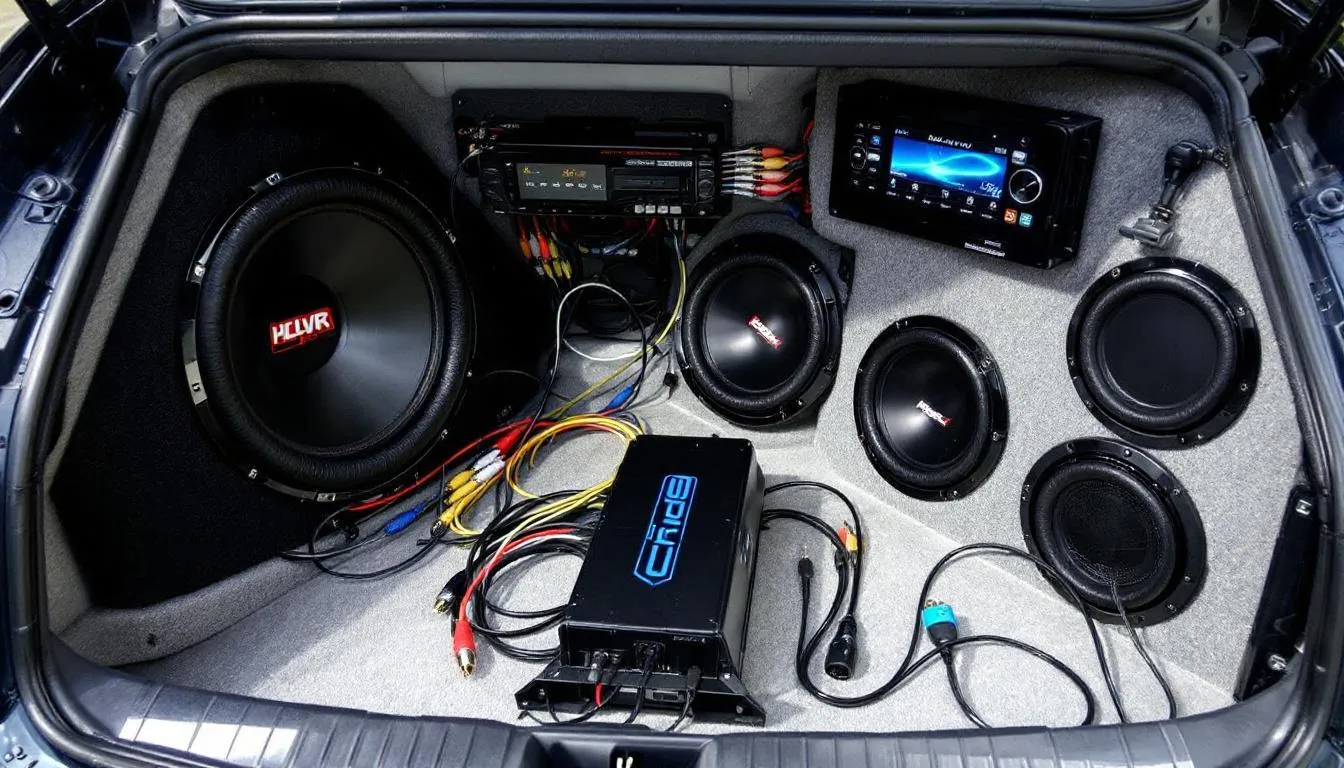
Smartphone Integration
Smartphone integration has become a must-have feature in modern car audio systems, transforming your vehicle into a connected multimedia hub. With advanced head units supporting Apple CarPlay, Bluetooth, and GPS navigation, you can easily play music, access your favorite apps, and get real-time directions—all from your car’s dashboard. These systems allow you to make hands-free calls, send messages, and control your music library without ever taking your eyes off the road.
Many car audio systems now offer wireless connectivity, making it easy to connect and disconnect your smartphone without fumbling with cables. This seamless integration means you can start your playlist, launch navigation, or answer calls with just a tap or voice command. When selecting a car audio system, consider the level of smartphone compatibility it offers, ensuring it supports your device and the features you use most often.
Car audio retailers are a valuable resource when it comes to choosing the right system for your needs. Their staff can help you compare options, explain the benefits of different integration features, and recommend systems that fit your vehicle and lifestyle. Whether you want to stream music, use GPS navigation, or enjoy the convenience of Apple CarPlay, the right car audio system will make every drive easier and more enjoyable.
Customization
One of the greatest advantages of modern car audio systems is the ability to customize your setup to match your unique preferences and driving habits. Whether you’re looking to upgrade your system’s performance or add new features, customization options abound. Many car audio systems let you fine-tune sound with adjustable equalizer settings, crossover frequencies, and time alignment, so you can achieve the perfect audio balance for your favorite music genres.
For those seeking even more from their car audio, adding accessories like subwoofers, amplifiers, and tweeters can dramatically enhance sound quality and depth. These upgrades allow you to tailor your system to your vehicle’s size and shape, as well as your personal taste in music. Whether you crave deep bass, crisp highs, or a balanced soundstage, there’s a combination of components to fit your needs.
When planning a custom car audio system, consider how you use your vehicle, the types of music you enjoy, and your expectations for performance. Car audio retailers can provide expert guidance, helping you select the right accessories and features to maximize your investment. With the right customization, your car audio system will deliver a driving experience that’s as unique as you are.
Advanced Features
Today’s car audio systems are packed with advanced features that go far beyond basic music playback. Satellite radio and HD radio offer access to a vast array of stations and genres, ensuring you always have something new to listen to on every ride. Built-in GPS navigation provides turn-by-turn directions and real-time traffic updates, keeping you on track wherever your journey takes you.
Many car audio systems now include voice command capabilities, allowing you to control your system hands-free for added convenience and safety. With just your voice, you can change stations, adjust volume, or launch navigation, all while keeping your focus on the road. When shopping for a new car audio system, think about which advanced features matter most to you and how they’ll enhance your driving experience.
Car audio retailers can walk you through the latest features and help you compare systems based on your needs and comfort level with technology. By choosing a system with the right mix of advanced features, you’ll enjoy a more connected, entertaining, and convenient ride every time you get behind the wheel.
Installation Options
Choosing between DIY installation and professional service significantly impacts both your immediate costs and long-term satisfaction with your car audio system. Each approach offers distinct advantages that appeal to different customer priorities and skill levels.
DIY installation can provide substantial cost savings for mechanically inclined individuals with appropriate tools and patience. Basic speaker replacement often requires only screwdrivers and wire strippers, potentially saving $100-300 in labor costs. However, modern vehicles increasingly feature complex integration requirements that challenge even experienced DIY enthusiasts. Electrical connections must be properly secured to prevent short circuits or interference with vehicle electronics.
The skill level required varies dramatically based on system complexity and vehicle type. Simple coaxial speaker replacement typically requires basic hand tools and following color-coded wiring diagrams. Head unit installation often involves dash disassembly and may require special removal tools specific to your vehicle brand. Component speaker installation with external crossovers demands understanding of electrical principles and careful attention to phase relationships between drivers.
Professional installation offers expertise and warranty protection that justifies the additional cost for many customers. Experienced installers understand vehicle-specific challenges and have specialized tools that ensure proper integration with existing systems. The guys at the shop can also assist with setting up and testing features like CarPlay to make sure everything works seamlessly. Professional work typically includes warranties covering both labor and components, providing peace of mind for expensive upgrades.
Typical installation timeframes range from 2-6 hours depending on system complexity and vehicle requirements. Simple speaker replacement might be completed in under two hours, while comprehensive system upgrades including amplifiers, subwoofers, and sound deadening can require a full day of work. Professional shops can often provide accurate time estimates after assessing your specific vehicle and chosen components.
Installation costs generally range from $100-500 depending on system complexity and local labor rates. Basic speaker installation typically costs $50-150, while complete system installations including custom fabrication work can exceed $500. These costs often represent good value when considering the specialized knowledge and tools required for proper installation.
When to choose professional installation depends on several factors including vehicle complexity, system sophistication, and your comfort level with automotive electrical work. Newer vehicles with integrated infotainment systems almost always benefit from professional installation to maintain warranty coverage and system functionality. High-end systems with multiple amplifiers and custom enclosures require expertise that most DIY enthusiasts lack.
Maintenance and Troubleshooting
Keeping your car audio system in top condition is essential for long-lasting performance and enjoyment. Regular maintenance, such as cleaning the head unit, speakers, and subwoofers, helps prevent dust and debris from affecting sound quality or causing technical issues. It’s a good idea to periodically check all system components for loose connections or signs of wear, ensuring everything is working as it should.
If you encounter problems with your car audio system, start by identifying the source—whether it’s the head unit, speakers, or wiring. Many modern systems include built-in diagnostic features that make troubleshooting easier, helping you quickly pinpoint and resolve issues. For more complex problems, car audio retailers offer expert support, guiding you through repairs or recommending professional service when needed.
By staying proactive with maintenance and addressing issues promptly, you’ll protect your investment and enjoy consistently high performance from your car audio system. A well-maintained system means better sound, fewer interruptions, and a more satisfying driving experience.
Safety Considerations
While car audio systems can make every drive more enjoyable, it’s important to prioritize safety whenever you’re behind the wheel. Distractions from adjusting your system or searching for music can increase the risk of accidents, so always use features like voice commands and steering wheel controls to keep your attention on the road. Many car audio systems now include safety-focused features such as backup cameras and parking sensors, which help improve driver awareness and reduce the chance of collisions.
When choosing a car audio system, consider how its design and user interface support safe operation. Look for systems with intuitive controls, clear displays, and hands-free capabilities that make it easy to manage your music and navigation without taking your eyes off the road. Car audio retailers can offer advice on the safest options for your vehicle and driving style, ensuring you get a system that enhances both your enjoyment and your safety.
By making smart choices and using your car audio system responsibly, you can enjoy all the benefits of upgraded sound and features while keeping yourself and others safe on every drive.
Financing and Payment Options
Modern financing options make quality car audio upgrades accessible to customers regardless of their immediate cash availability. Understanding these options helps you acquire the system you want while managing costs effectively.
Lease-to-own programs through companies like Acima provide immediate access to premium car audio systems without requiring traditional credit approval. These programs allow you to acquire ownership gradually through monthly payments, often with flexible terms that accommodate varying budgets. Acquiring ownership through lease-to-own agreements typically occurs after all scheduled payments or lease terms are completed. Not all applicants qualify for lease-to-own programs, but approval requirements are typically less stringent than traditional financing options. Please note that certain financing and lease-to-own programs may not be available in states like MN (Minnesota), NJ (New Jersey), WI (Wisconsin), and WY (Wyoming) due to regulatory restrictions.
Installment financing with 0% interest promotions can make expensive upgrades more manageable by spreading costs over several months without additional fees. Many retailers offer qualified customers these promotional terms during peak sales periods, effectively allowing you to pay the retailer’s cash price over time. The retailer's cash price serves as the baseline for calculating payment plans and lease-to-own agreements. These programs often require good credit scores and may include restrictions on purchase amounts or eligible products.
PayPal Credit and Buy Now, Pay Later services have become increasingly popular for online purchases, allowing customers to spread payments over weeks or months with minimal approval requirements. These services often provide instant decisions and can be used at participating online retailers or physical locations that accept PayPal payments.
Credit requirements vary significantly among financing options. Traditional financing typically requires good to excellent credit scores (650+) and stable income verification. Alternative financing programs may accept lower credit scores but often include higher interest rates or fees. Many customers find that establishing relationships with local retailers can provide access to financing options not available through online purchases.
Cost comparison between cash purchases and financing requires careful attention to total costs including interest, fees, and promotional terms. While 0% financing effectively matches cash pricing, higher interest rates can significantly increase total costs over time. Customers should calculate total payments and compare them to available cash discount pricing when evaluating financing options.
Some retailers offer special programs for customers with limited credit history, providing paths to acquiring quality systems while potentially improving credit scores through timely payments. These programs often feature graduated payment schedules that start with lower payments and increase over time, accommodating customers with variable income situations.
Leasing costs for car audio systems can be attractive for customers who prefer the latest technology and don’t mind changing systems periodically. Some programs offer upgrade paths that allow customers to exchange systems for newer models, ensuring access to the latest features and connectivity options.
Professional installation financing is often available separately from equipment financing, allowing customers to spread both product and service costs over comfortable timeframes. Many shops work with multiple financing companies to provide options for various credit situations and budget requirements.
The easy way to explore financing options involves visiting local retailers and discussing your specific situation with knowledgeable staff. Many shops can pre-qualify customers for financing programs and explain terms before committing to specific products or installation services. This approach allows you to understand your options and make informed decisions about the best payment method for your circumstances.
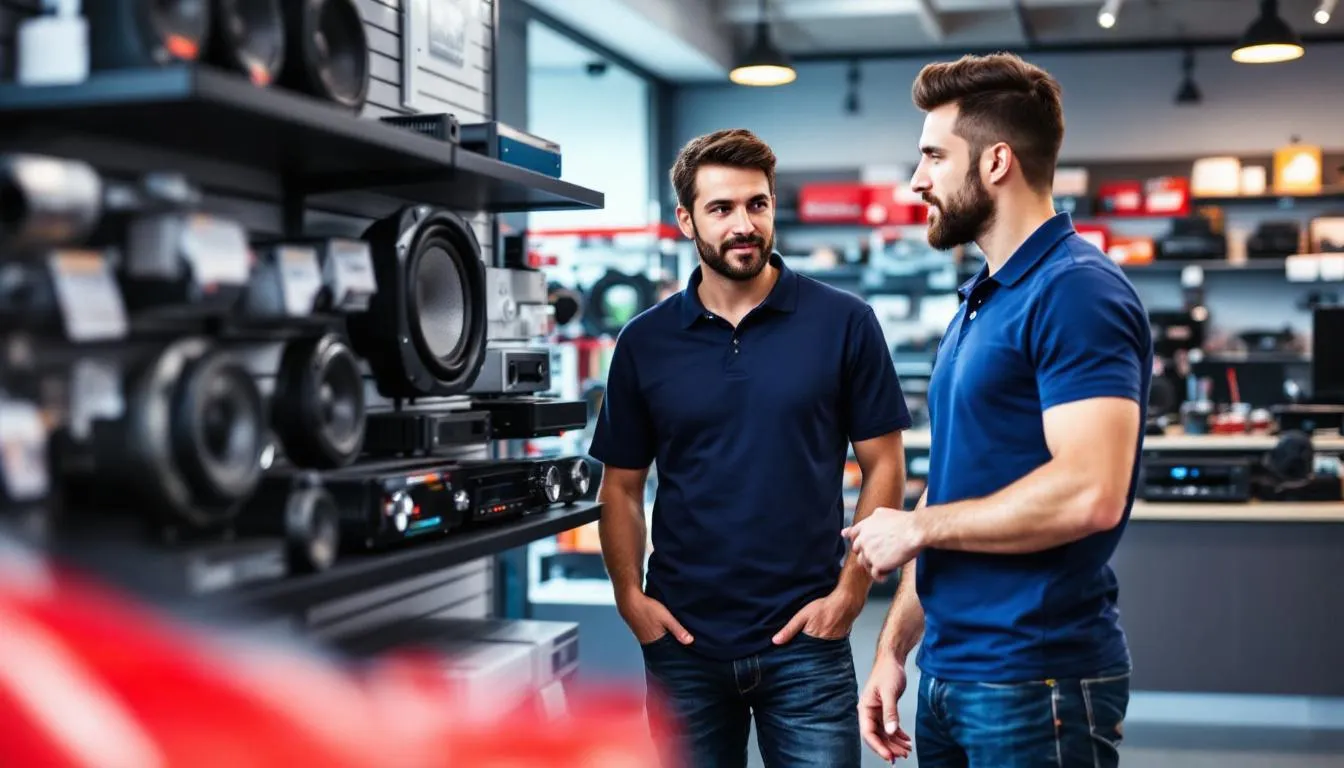
Working with reputable retailers and installation shops ensures you receive quality products and service while building relationships that can benefit future upgrades or service needs. Many car audio businesses operate as an LLC, providing customers with added trust and legal protection. Established businesses typically offer comprehensive support including product selection guidance, professional installation, and ongoing service for satisfied customers.
Whether you choose to pay upfront, finance your purchase, or explore lease-to-own options, investing in quality car audio dramatically improves your daily driving experience. The combination of superior sound quality, modern connectivity features, and enhanced convenience makes car audio upgrades some of the most worthwhile automotive accessories you can purchase.
Take time to visit local shops, explore different brands like Pioneer, Alpine, Sony, and Kenwood, and listen to various systems to determine what sounds best to your ears. Bring your friends along to get additional perspectives, and don’t hesitate to ask questions about installation requirements, warranty coverage, and financing options. The right car audio system will provide years of listening enjoyment and transform every ride into an awesome experience worth the investment.
Car audio technology continues advancing rapidly, with new features and capabilities emerging regularly. By choosing quality components and professional installation, you’ll be well-positioned to enjoy the latest innovations while maintaining the performance and reliability that make car audio upgrades such valuable investments in your driving life.

